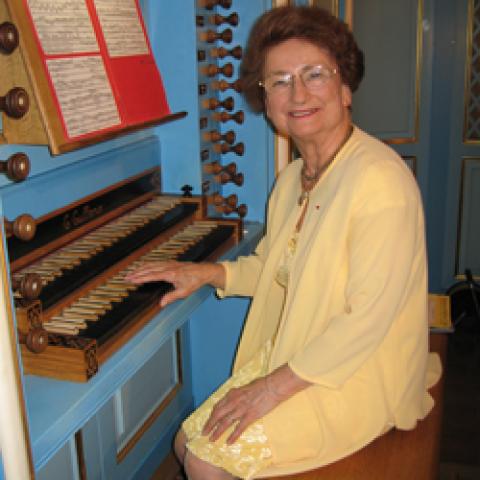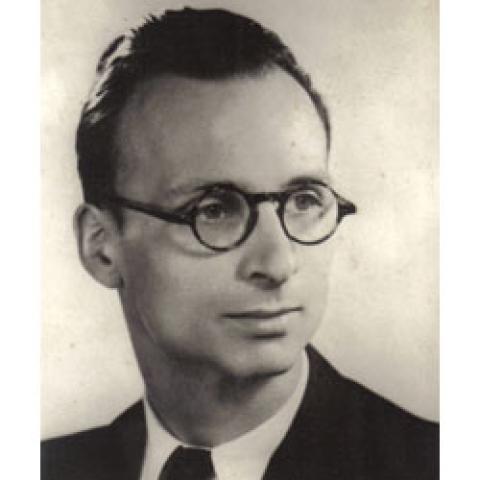The world’s most distinguished concert organist, Marie-Claire Alain, died at the age of 86 on February 26, 2013, in Le Pecq, France
James David Christie holds positions as the Distinguished Artist in Residence at the College of the Holy Cross, Worcester, Massachusetts, Chair and Professor of Organ at the Oberlin College Conservatory of Music, Oberlin, Ohio, and serves as College Organist at Wellesley College, Wellesley, Massachusetts. He has previously held positions at Boston Conservatory, Harvard University, M.I.T., and Boston University. He has served as organist of the Boston Symphony Orchestra since 1978.
James David Christie has made over fifty tours of Europe and performs regularly in Canada, Asia, Australia, and Iceland. He has recorded for Decca, Philips, Nonesuch, JAV, Northeastern, Arabesque, Denon, RCA, Dorian, Naxos, Bridge, and GM and has received several awards for his solo recordings, including the Preis der Deutschen Schallplatten Kritik and the Magazine d’Orgue: Coup de Coeur. In the fall of 2010, he was on sabbatical in Paris, France, where he served as visiting Professor of Organ at the Paris Conservatory.

The world’s most distinguished concert organist, Marie-Claire Alain, died at the age of 86 on Tuesday, February 26, 2013, in Le Pecq, a small French commune located next to her home city of Saint-Germain-en-Laye. She had been in failing health for several months and the cause of her death was reported as a cardiac arrest. Madame Alain performed around the entire world, but always held her many American friends and audiences in her heart as her favorite public. She performed over 2,500 concerts and made over 280 recordings during her lifetime.
Marie-Claire Alain was born in Saint-Germain-en-Laye on August 10, 1926. Her father was the organist-composer Albert Alain (1880–1971) and her mother was Magdeleine Alberty (1890–1971). She had three siblings, all excellent musicians, who preceded her in death: her older sister, Marie-Odile Alain (1914–1937), and two brothers—the renowned organist-composer Jehan Alain (1911–1940) and Olivier Alain (1918–1994). Her father, Albert, was the organiste titulaire of the Church of Saint-Germain-en-Laye from 1924 until his death in 1971. Marie-Claire began assisting her father at the church in 1937 at the age of 11. She was appointed her father’s successor upon his death in 1971 and faithfully served as organiste titulaire for the following 40 years. She resigned in 2011 because of her declining health.
She studied at the Conservatoire national supérieur de Paris, where she was an organ student of Marcel Dupré; there she also studied harmony with Maurice Duruflé and fugue with Simone Plé-Caussade. At the Paris Conservatory, she won first prizes in organ, improvisation, fugue, harmony, and counterpoint. She studied organ privately with Gaston Litaize and André Marchal; both of these famous teachers were important mentors in her career and played a great role in her artistic development.
Marie-Claire Alain was an extraordinary teacher and her students have won a staggering number of international competitions. Today her students hold some of the most important and prestigious teaching and church positions around the world. Marie-Claire Alain was professor of organ at the Conservatoires nationaux de région in Rueil-Malmaison (1978–1994) and Paris (1994–2000). Prior to and even after 1978, she always had a very large private studio and taught many of the most famous organists of today on her Haerpfer-Erman house organ at her homes in L’Étang-la-Ville and Maule, as well as at the Church of Saint-Germain-en-Laye. Madame Alain taught every summer in the Netherlands at the Haarlem Summer Organ Academy with her close friends and colleagues Anton Heiller and Luigi Ferdinando Tagliavini from 1956–1972; after 1972, she returned to teach at Haarlem on three occasions in 1974, 1982 and 1994. She also founded and taught at the Académie Jean-Sébastien Bach de Saint-Donat from 1971–1991. From 1991 to 2009, she was a permanent member of the organ faculty for the Académie d’orgue de Romainmôtier, Switzerland. In 1985, Marie-Claire Alain donated the family house organ, built by her father between 1910 and 1971, to the Jehan Alain Association in Romainmôtier. Madame Alain’s last teaching in North America took place at the McGill Summer Organ Academy, Montreal, Quebec, Canada, in July 2007, and her very last trip to North America was as a juror for the First Canadian International Organ Competition in Montreal in the fall of 2008. She served on that jury with five of her former students: John Grew (Artistic Director of the CIOC), Dame Gillian Weir, James David Christie, Ludger Lohmann, and James Higdon.
The list of awards and honors given to Marie-Claire Alain is immense. She received honorary doctorates from Colorado State University, Southern Methodist University, the Sibelius Academy (Helsinki), the Boston Conservatory, McGill University, and Johns Hopkins University. She was awarded the Prize of Les Amis de l’Orgue, the Edison Prize (Holland), the Golden Disque Award (Japan), the Prize of the President of the Republic (Académie Charles-Cros), and the Buxtehude Prize (Lübeck). In addition, she was awarded the Grand Prix du Disque (Académie Charles-Cros) sixteen times, the Léonie Sonnig Foundation Prize (Copenhagen), the Franz Liszt Prize (Budapest), the Golden Laser Prize of the Académie du Disque Français, and 1984 International Performer of the Year (New York City chapter of the American Guild of Organists). She has received numerous “Diapasons d’or” for her outstanding recordings. Marie-Claire Alain was a member of the Royal Academy of Music, Stockholm and the Royal Academy of Music, London. She was made a Chevalier in the Royal Order of Danneborg (Denmark). She held the rank of Commandeur in the Légion d’honneur, the Ordre national du Mérite and the Ordre des Arts et Lettres. French President François Hollande promoted Madame Alain to the rank of Grand Officier in the Ordre national du Légion d’honneur on July 14, 2012.
Marie-Claire Alain’s impressive list of recordings includes three versions each of the complete organ works of J.S. Bach, François Couperin, Nicolas de Grigny, and Jehan Alain, two versions each of the organ concerti (with orchestra) of G.F. Handel and the organ works of César Franck, and complete recordings of the organ works of Buxtehude, D’Aquin, Bruhns, Böhm, and Mendelssohn. She recorded organ concerti by Poulenc, Charles Chaynes, Haydn, C.P.E. Bach, Vivaldi, Mozart (Church Sonatas), and two recordings of Symphonie III of Saint-Saëns. Madame Alain appeared as a continuo artist on dozens of recordings, many with the Jean-François Paillard Chamber Orchestra. She also has recorded many works by Liszt, Pachelbel, Vierne, Widor, Messiaen, and others. Madame Alain performed and recorded with the legendary flutist Jean-Pierre Rampal and the acclaimed trumpet virtuoso Maurice André. For a complete discography, please consult Alain Cartayrade’s thorough listing in the French publication L’Orgue, Cahiers et Mémoires No. 56, 1996; the listing may also be read online: www.france-orgue.fr/ (to access the listing, type in “Marie-Claire” in the box marked “Recherche rapide organist” on the right side in the middle of the page).
Marie-Claire Alain married Jacques Gommier, a musician and choral conductor, in 1950; he died in 1992. Monsieur Gommier was a wonderful husband and often handled her correspondence and did musicological research for Madame Alain. He never complained or corrected anyone when he was addressed as ‘Monsieur Alain’ when he accompanied his wife on her many North American tours! They had two children: a son, Benoît, who died in 2009 at the age of 57, and a daughter living in Paris, Aurélie Decourt, musicologist and author of several books on the Alain family. Dr. Decourt organized a national French celebration and festival held in Saint-Germain-en-Laye for the 2011 centenary of the birth of Jehan Alain; she also appeared at Alain centenary events in the United States. [See articles in The Diapason: “Marie-Claire Alain—80th birthday tribute” (July 2006), “National French Centenary Celebration of the Birth of Jehan Alain” (November 2011), “Jehan Alain—The American Festival: Wichita State University” (January 2012), and “Jehan Alain: His Life and Works” (July 2012).] She took extraordinary care of her mother in her last years, and this was greatly appreciated by Madame Alain’s family and friends. In addition to her daughter, Marie-Claire Alain’s survivors include six grandchildren, one nephew, and two nieces (the three children of Jehan Alain: Lise, Agnès, and Denis).
Madame Alain’s funeral took place at the Church of Saint-Germain-en-Laye on Friday, March 1 at 10:00 am. Her coffin was placed under the Grand Orgue in the church before and after the service. The church was full and the congregation was filled with her many friends from Saint-Germain-en-Laye and Paris, as well as musicians and many organists from Paris, France, and western Europe. Several organists played works of J. S. Bach and Jehan Alain for the service, including former Marie-Claire Alain students Vincent Warnier, Daniel Roth, Bruno Morin, Jean-Baptiste Robin, and Jean Ferrard. A small Gregorian choir sang parts of the Requiem Mass. Her daughter, Aurélie, gave a touching eulogy and spoke lovingly of her mother’s last difficult weeks and how optimistic she was about life. When she would ask her mother how she was feeling, she would respond that she was getting ‘better and better each day.’ As Madame Alain held the rank of Grand Officier in the Légion d’honneur, an honor guard carried the French flag into the church and gave a military homage when her coffin was taken outside the church at the end of the service. Marie-Claire Alain was buried next to her husband in the Gommier family plot in the “New Cemetery” of Saint-Germain-en-Laye.
The world has lost a great artist—we have lost a great inspiration, an exceptional human being, and a great friend. Thank you, Madame Alain, for making our lives so rich and so full of beauty—we will never forget you. May your soul rest in peace, now and forever—Amen.




